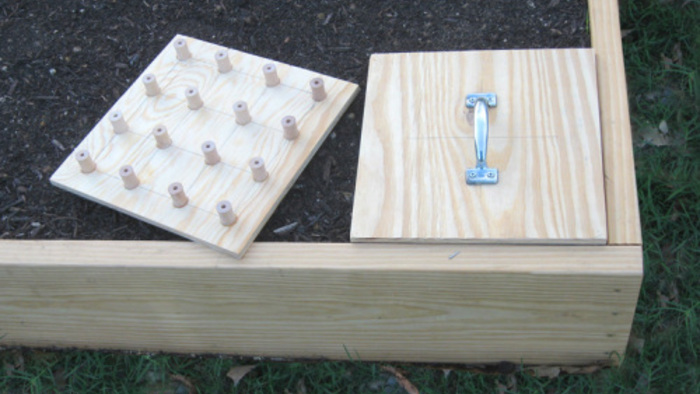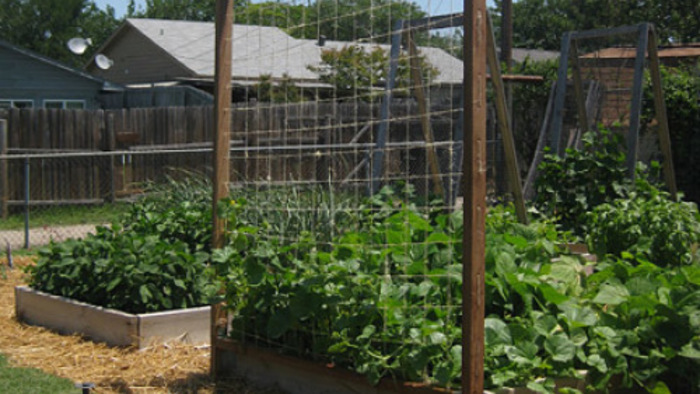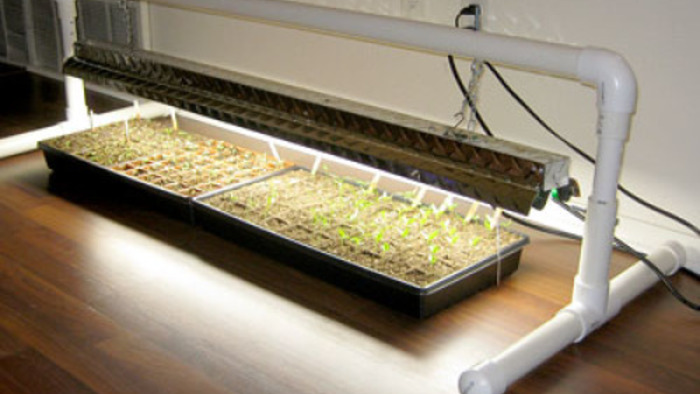
One of the most critical tasks in growing your own transplants is making sure they have consistent moisture. This can be time-consuming if you’re growing a lot of them. Not to mention occasions where one might not be able to water them as often as they would like, be on vacation, etc. For the most part this problem is now solved!
This transplant tray is almost totally self-watering and self maintaining. Here’s how it works once it is set up and timed correctly:
 |
|
| Photo A | |
 |
|
| Photo B | |
 |
|
| Photo C | |
 |
|
| Photo D | |
 |
|
| Photo E | |
At a set time, water is pumped from the bottom reservoir into the top tray, providing a high-enough water level to wick some of the water into the transplant containers, watering them. Holes drilled at the four corners prevent this water level from rising too high.
The water continues to be pumped into the tray for a set time until it is shut off by the timer. By then, the transplants have received enough water to moisten the soil media that they’re in. But, it’s not a favorable condition for the transplant’s soil to be constantly moist, as their roots need to “breathe”. Holes drilled into the bottom of the top tray allow the water to quickly drain out, thereby allowing the soil to (at least partially) dry out.
Yes, I know… nothing can be totally self-watering and self-maintaining. This setup does require occasional maintenance, such as replacing fresh water lost in evaporation, or that’s gotten dirty. But for the most part, this is a “set it and forget it” setup.
The list of things you’ll need:
• 1 – 25 quart (24 liter) clear plastic storage container
• 1 – 51 quart (48 liter) clear plastic storage container (photo A)
• 2 ft. – 1/4″ or 3/8″ clear plastic tubing (photo B)
• 1 – low-volume fountain or other water pump. I used a 70 gph unit (photo C)
• Electric timer (preferably 3-prong)
• Electrical extension or power cord
• Drill & drill bits
• Knife or small saw
• Permanent marker
• Two-to-three-prong electrical plug adapter (only if needed).
Note: The two plastic containers need to be the same width and length, and the shorter container has to fit inside the taller one.
Skill Level:
Easy
Construction:
1. Place the smaller storage container inside the larger one and mark on the outside of the larger container it where it ends. You’ll need that later.
2. Fill the top storage container with enough water to completely cover the bottom of it. Depending on the container, the depth of the water at this point shouldn’t be more than a half inch. This is going to be the highest point at which the water will rise above the bottoms of the transplant containers (photo D).
3. Put a mark at each of the four corners, right at the top of the water level. This is an important measurement, as it will become the overflow points. That way, if something goes awry, they won’t be overwatered (photo E).
4. Drill a 1/4″ hole at these four points. When the water reaches the holes, it will drain out into the bottom storage container.
5. Using the marks you made in Step 1, drill a 1/4″ or 3/8″ hole (depending on the diameter of the tubing you have) in the short side of the bottom container, about an inch or so below the mark. This is for the plastic tubing to come out of (photo F).
 |
|
| Photo F | |
 |
|
| Photo G | |
 |
|
| Photo H | |
 |
|
| Photo I | |
 |
|
| Photo J | |
 |
|
| Photo K | |
 |
|
| Photo L | |
6. Cut a hole on the short side of the bottom container, about an inch or so below the mark, on the opposite side of the hole made in Step 5. This hole is for the water pump’s cord/plug to fit through.
7. Drill a similar-sized hole in the top container, in the space between the edges of the two containers. This is for the tubing to go into the top container (photo G).
9. Attach the tubing to the water pump (photo H). I ended up “jerry-rigging” the connection with a brass hose barb adapter (1/4″ barb x 1/4″ MIP), since it provided a firmer connection to the pump.
10. Position the water pump inside the bottom container, preferably on the same side as the holes made in Steps 7 & 8. Straighten out the cords/tubs if necessary (photo I).
11. Run the tubing through the bottom container’s hole and then through the top container’s hole.
12. Plug the water pump in to test it.
13. Connect the power/extension cord to the timer, and then to the water pump (photo J). I had to get a two-to-three-prong electrical plug adapter since my timer only had a two-prong plug.
At this point, your ready to put in your transplants (photo L). This is where the “experimenting and testing” begins. Since everyone’s growing conditions (temperature, humidity, wind, etc.) is different, you’ll have to set up the “timing” for your area.
14. With the transplants in the tray, turn on the water pump until the water is draining out of the four corner overflow holes in the top tray. Then, stop the pump. Drill 4 holes in the bottom of the top tray, either in the middle or on the edges, allowing the water to completely drain out. The water should be completely drained out in a couple minutes. This is your starting point for the tray.
15. Set the timer to only run for the smallest increment it can (mine is in 15-minute increments). This is your starting point for the timing (photo K).
16. Let the setup run on it’s own with the timer running for a day or two. Observe the transplant’s soil carefully to see if it is being allowed to at least partially dry out. If the soil is not drying out, you will need to drill more holes in the top tray to shorten the drain time.
At some point you will have your setup running with the right amount of time for the transplants to get properly watered, but not overwatered. Believe me, the time put into setting it all up is well worth the time you’re going to save watering (not to mention the lost stress).
More DIY projects…
Square-foot planting templates
Fine Gardening Recommended Products

Gardena 3103 Combisystem 12-Inch To 20-Inch Adjustable Metal Fan Rake Head
Fine Gardening receives a commission for items purchased through links on this site, including Amazon Associates and other affiliate advertising programs.

SHOWA Atlas 370B Nitrile Palm Coating Gloves, Black, Medium (Pack of 12 Pairs)
Fine Gardening receives a commission for items purchased through links on this site, including Amazon Associates and other affiliate advertising programs.



















Comments
Log in or create an account to post a comment.
Sign up Log in